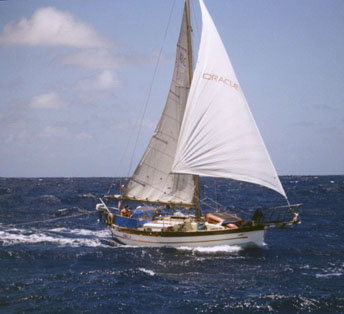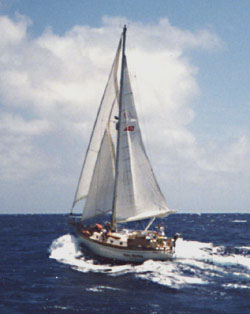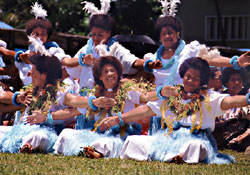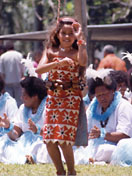Chapter 14 - Tonga and Fiji NuiatoputapuThe small island of Nuiatoputapu, a.k.a "New Potatoes" by many of the cruisers, is less than 200 miles south of Western Samoa, and a logical port of entry to Tonga. We had fabulous weather and winds the first day, but then it turned ugly. Along with a few squalls, the seas increased to ten feet, and the wind built up to 31 knots. We could see there was no way to reach Nuiatoputapu before dark, so we had to hove to all night long in these rough conditions. For almost 18 hours we were hove to, moving very slowly at 1 knot, as the winds howled. A little after sunrise we went through the pass in the coral reef around Nuiatoputapu; the seas flattened out, but the winds and the lousy weather continued. Six other boats were already anchored there. The Tongan immigration, customs, and health officials all wanted to be dinghied out to our boat to complete the necessary paper work. When there, they asked for beer and soda. This was a "first" for us, but we had been forewarned over the radio to give them one can. Adolf, on Rose'l, said he didn't have beer or soda, and offered a drink of liquor. When the custom's man left, he asked to take the bottle, to which Adolf agreed very reluctantly. In Tonga we had crossed the International Date Line, even though the longitude was still West. From Apia, which is 11 hours slow on GMT, we went to Tonga which is 13 hours fast. Thus we didn't change our clocks, or, more precisely, we moved them forward 24 hours! The people of Nuiatoputapu were the dirtiest, poorest, we had yet encountered. There were many, many pigs and goats roaming around freely, indicating a certain level of wealth, but there was very little agriculture. Hurricane Ofa last February had really devastated this island, blowing the roofs off many houses and ruining their fields. The adults were friendly, but kept their distance, while the children always stopped to talk to us. The small children nearest the dinghy dock would run to us, waving, saying "hello," and asking for a "lolly." They had been "trained" by previous cruisers, including ourselves, who give small candies to the kids. Most of these Tongans spoke English and were quite friendly. We went to a Tongan feast put on by Ofisi for $10 per person. Thirteen of "us yachties" sat down on mats inside an open "fale," and ate with our fingers, Tongan style. The many dishes included a spicy and tender octopus dish, taro leaves and fish, raw clams with onion and lime, pork, manioc (like potatoes), watermelon, papaya, and a desert with corn and caramel, all washed down with drinking coconuts. We were stuffed. Both of us, but especially Candace, were nervous eating such strange food which had been prepared under obviously primitive, unsanitary conditions. It was fun to do once. To work off some of the gigantic meal, I played cricket with some 8 to 10 year old boys. They seemed to enjoy that a lot. They were quite appreciative of the tennis ball we gave them the next day. Some charming 14-15 year old girls asked us for US magazines, and we gave them a National Geographic and Reader's Digest. < Vava'uPrimarily because of the poor weather, we were eager to leave Nuiatoputapu. We left as soon as we got a slight break in the windy weather that had continued since our arrival. Wrong! Outside the pass it was still blowing 30 knots, with waves from 15 to 18 feet. At one point the waves were as high as the spreaders - approximately 22 feet up. Wow! We turned around and retreated back to Nuiatoputapu for another day. The next morning the seas had calmed down, and we headed south to Vava'u under ideal sailing conditions. After a day, the winds had subsided to a mere 5 knots, so on went the motor for the last 70 miles. We made water the whole way and arrived with topped off batteries and water tanks, but of course a little less diesel. With the Middle East crisis, and the subsequent rise in oil prices, we're starting to husband our diesel supply more closely. The Vava'u Group of Tongan Islands is reminiscent of the San Juan Islands. There are more than fifty small islands, all within a few miles, and all within a large fringing reef which protects them from the ocean swell. The weather was primarily overcast, so that too reminded us of the Northwest. However, that's where the comparison stops. In the crystal clear water, we could easily see our anchor 30 feet below, hundreds of rainbow colored fish, white sand, and coral. Overhead we saw several fruit bats (a.k.a. flying fox) which are rare except for Tonga and Fiji. It had been six months since we'd last touched our brightwork. So we found the energy to tackle that job once again. After sanding, we waited for a nice dry day to apply the first coat of varnish . . . and we waited. Because of the rain, we needed ten days to apply three coats. It was much easier this time. We had learned from Arjumand that it's not necessary, and perhaps best, not to sand in between each coat. I even found the time to clean and wax the hull. Baba BarAnn looks great and has finally been cleansed of Pago Pago. The Canadians arranged a nice pot luck for all the Canucks and those with a Canadian courtesy flag, like Baba BarAnn, to celebrate their Thanksgiving. They also arranged a book swap in conjunction with the pot luck. Almost everyone is looking for new literature, so this was a good opportunity. We also met up again with Martin on Orca. Karin had returned to Sweden and he was soloing his Hans Christian 34. Tonga was really nice, one of our favorite places, but we had to keep moving. Our mail was waiting for us in Suva, Fiji, 450 miles to the west. In between there are numerous uncharted reefs, islands, shoals, and "discolored water." They're due to the ash from recent, and continuing, underwater volcanic activity. The Pilot book even warns you to avoid pumice floating on the water, from any recent eruption, since it could easily clog a water cooled engine. For this passage I also tracked the weather very carefully, getting a weatherfax (with the ham radio and the computer) and listening to weather reports. The weather had been pretty bad recently, and we wanted to pick the best possible departure date. < Passage to Fiji
We were as prepared for this passage as we could be. We'd topped off the diesel tank, the water tanks were full, we were rested, Candace had made several meals in advance, and we had thoroughly studied the weather and the tricky route ahead of us. After checking out with customs and immigration, we left Tonga Saturday morning, October 13, under beautiful sunny skies and favorable 20 knot winds. Orca had left before us, and had an eight mile lead. The race was on! We were in VHF contact with Orca the entire way. At noon the first day, Martin jokingly warned us about a hamburger he'd dropped over-board. I said "Thanks for telling us about the uncharted beef!" It took us 30 hours to pass him. We both got out our cameras and took many pictures of each other, passing as close as 100 feet. Bright sunshine, surfing down eight foot waves with 16-20 knot winds on a broad reach, about 100 miles from land. This was fantastic sailing! It's really rare to see another sailboat on a passage, let alone pass within a few boat lengths. Good winds and great sailing continued until just 42 miles out of Suva. So on went the motor to charge our low batteries and speed us to Fiji. We averaged 6 knots . . . 140 miles per day. The weather was perfect. Overall, it was the best passage we've had yet. Fiji - Navigational Waste Land
Our original itinerary for the South Pacific had excluded Fiji. Its navigational problems are legendary, with numerous coral reefs and tricky currents. New islands and reefs are continually being formed by new volcanic activity. The first "Notice to Mariners" I read in Suva warned of an "underwater explosion at location . . . " The only people we had talked to, with first hand knowledge on Fiji, were soured by their experience. They had hit a reef and done some expensive, but repairable, damage, to their keel. Along with these problems are the stories of surly custom's officials and a reputation for not being very friendly toward cruisers. Who needs it?
Thumbnail History of FijiStarting in the 1880's, there was extensive importation of indentured servants from India to work on the sugar plantations. After ten year's labor, they could choose to return to India, or stay in Fiji. Most stayed. When this system ceased in 1916 the sugar fields were divided into 4 hectare plots and many of the Indians became tenant farmers. Others gravitated toward Suva, to become shop keepers or garment factory workers. In almost every way, these Indians were/are different from the Fijians. Picture the large, bulky, Polynesian with Afro haircut, whose heritage in a land of plenty has fostered an easy going lifestyle with community property rights and generosity, tempered by the recent, yet strong influence of the Christian church. Into this world comes the scrawny Indian, with stringy hair and weird smelling food, whose heritage has taught survival in an over-populated land, whose Hindu religion and traditions are so foreign. Not too surprisingly, these two cultures in Fiji have remained totally separate . . . and they always will. The number of Indians grew to 51% of the total population in Fiji by 1946. Despite their slight majority, and the laws that give lip service to equal rights, the Indians have not, and will never, be able to achieve political equality. Tension reached the breaking point in 1987, when political power was grabbed by a pro-Fijian group in a bloodless coup. Since then, many Indians have left the country, returning a majority to the Fijians, and probably making life even more difficult for the remaining Indians. < Suva, FijiInto this boiling cauldron sails Baba BarAnn. Over in the quarantine area of the anchorage, we spot Chuck motoring his dinghy in little figure eights. Just like a honey bee announcing a good nectar source to the rest of the hive, he's showing us an appropriate place to drop the hook and wait for the health officials to give us clearance. We hoist the yellow Q flag, contact the Port Control on the VHF, and wait. Shortly, a boat pulls up (smashes into us) and a health official comes on board. We struggle to understand his mumbling English, but fill out the forms and complete the process. Unfortunately, he's forgotten the form he must give us, but, not to worry, he'll drop it off tomorrow. The whole process was a complete joke. There was no action taken, nor question asked that was directed toward guarding the health of Fiji.
We then reanchor, close to the Royal Suva Yacht Club, and the next morning dinghy over to check in with them. The RSYC is the social center for cruisers in Suva. Sara in the office is a smiling, attractive Fijian with an impeccable English accent. After she calls immigration, they drive to the yacht club to meet us. What a switch. We complete reams of paper work, but it goes swiftly. Then we take a cab to the port control building to repeat/complete the process. It's really unfortunate that the British have taught them to drive on the wrong side of the road, and given them a love for paperwork! Suva is a large, modern, busy city. What a total change from Tonga. There are paved roads, street lights, multi story modern buildings, buses, cabs, hoards of people. Music blares in every store (American country and western is often the choice). The large public market has excellent fruit and vegetables, with good prices. After so many months, our senses were ready for a little overload. The air is filled with the smell of different curries, coriander, and kava, along with the sounds of horns, honky tonk, and hare krishna. Indians and Fijians. Side by side. Each quite distinct, separate, and fascinating. We lunch at tiny restaurants on very hot curry and Chinese food. We dine in style on steaks, mahi mahi, and wiener schnitzel. For the first time in eleven months, we tie up to dock at the RSYC and live in style, not having to take a dinghy to shore. The yacht club has happy hours, cookouts, fish and chips. We meet new cruisers, and become better acquainted with some others we've known for months. Suva is fun. One day we were greeted by our friend and real estate agent, Anne Bentrott, and her husband Kenny Wise from West Seattle. We learned they would be vacationing in Fiji in October, and told them to look us up at the RSYC. It's rare that meetings based upon such sketchy details ever take place, but there they were on the dock in Suva, 5,000 miles from Seattle. We enjoyed hearing news from our neighborhood and about the new tenant she had found to rent our house. That evening they invited us to dine at their hotel. What a nice surprise visit. They left the next day, back to the cold and rain of Seattle, and it was time for us to start planning our departure for New Zealand.
|



